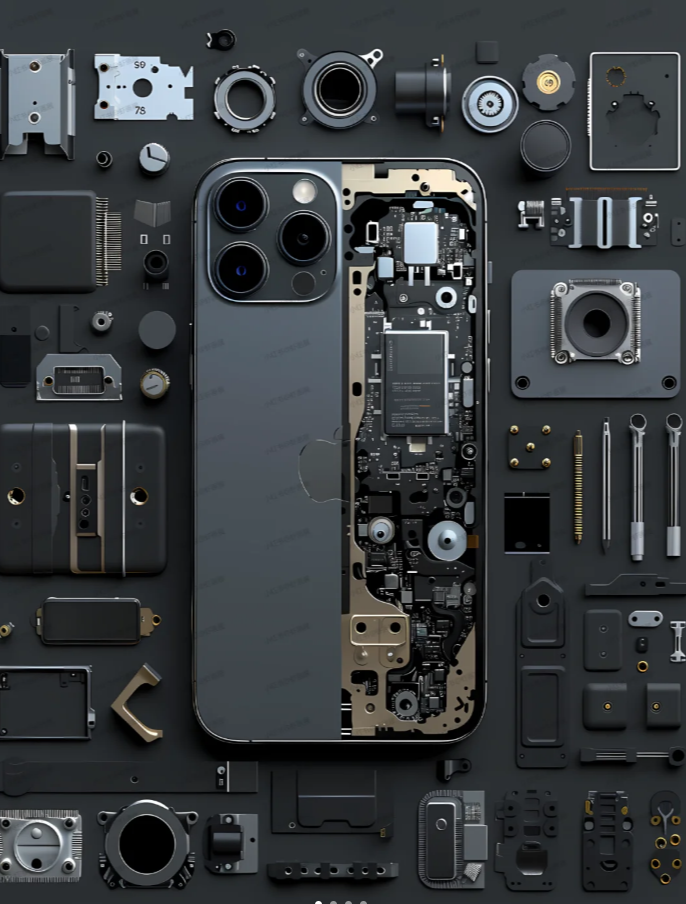Application examples of semi rigid flex PCB in mobile phones
In modern life, mobile phones seem to have become a necessity for people, and our daily lives are inseparable from them. Various activities such as communication, entertainment, shopping, and reading can all be accomplished through mobile phones, providing immense convenience to people's lives. It can be said that the compact mobile phone embodies the wisdom of modern civilization. The design of mobile phones has evolved from the initially bulky analog communication devices to today's powerful smart terminals. As smartphones rapidly advance towards thinner, lighter, higher-performance, and multifunctional designs, traditional rigid printed circuit boards (Rigid PCBs) and purely flexible printed circuit boards (Flex PCBs) can no longer meet the demands of complex designs. Semi-Rigid Flex PCBs, as a new circuit board technology that combines rigid and flexible areas, have become one of the core components in the design of modern high-end smartphones, thanks to their unique structural advantages.

1. What is a Semi-Rigid Flex PCB?
A semi-rigid flex PCB is an advanced version of traditional rigid-flex PCBs. It is a printed circuit board that combines both rigid and flexible materials, built on a flexible base. This design allows specific parts of the PCB to bend or stretch while maintaining structural integrity in other areas. Essentially, it provides the stability of a rigid PCB along with the flexibility of a flex PCB within a single design.
Semi-rigid flex PCBs are commonly used in applications that require complex 3D circuit layouts due to space constraints. However, the proper application of rigid-flex PCBs can be challenging. It requires ensuring smooth electrical connectivity within limited space while securely connecting components, ensuring polarity and contact stability, and ideally reducing the need for connectors for easier component integration.
2. What Are the Advantages of Semi-Rigid Flex PCBs?
Space Saving
The main advantages of rigid-flex PCBs include dynamic and mechanical stability, increased design flexibility in three-dimensional structures, simplified assembly, space savings, and consistent electrical performance. These PCBs can be bent or folded to fit into tight spaces, eliminating the need for connectors and reducing additional interconnects.
Mechanical Stability
Semi-rigid flex PCBs offer high stability in applications requiring strong resistance to impact and vibration. Their design allows them to withstand mechanical stress, vibrations, and temperature fluctuations, making them highly durable with fewer potential failure points during use.
High-Frequency Signal Optimization
Through precise impedance control, semi-rigid flex PCBs reduce transmission loss in high-speed signals, such as those used in 5G and Wi-Fi 6 applications.
3. What Are the Disadvantages of Semi-Rigid Flex PCBs?
Higher Cost
Semi-rigid flex PCBs are generally more expensive than rigid or flexible PCBs due to their more complex manufacturing processes. Additionally, experienced PCB designers who specialize in rigid-flex designs are relatively scarce, increasing design costs.
Higher Manual Assembly Cost
Since flexible conductive layers replace traditional wired interconnections, assembly steps and labor costs can be reduced. However, in some cases, this design can enhance the product's reliability and performance, which may help lower long-term maintenance costs despite the higher initial assembly expense.
4. What is the difference between Rigid-Flex PCB and Semi-Rigid Flex PCB?
The main differences between Semi-Rigid Flex PCB and Rigid-Flex PCB lie in their structure, manufacturing methods, materials, and application scenarios:
(1) Structure
Rigid-Flex PCB
Combines rigid PCB (Rigid PCB) and flexible PCB (Flex PCB) through conductive layers and adhesive layers to form an integrated circuit board. The rigid sections provide structural support, while the flexible sections allow for bending.
Semi-Rigid Flex PCB
Primarily consists of flexible PCB, but certain areas are made "semi-rigid" by adding thickened cover layers (such as FR4 laminates). Unlike Rigid-Flex PCBs, it does not directly combine rigid and flexible PCBs.
(2) Manufacturing Methods
Rigid-Flex PCB
Requires a multi-layer lamination process, combining rigid materials (e.g., FR4) and flexible materials (e.g., Polyimide, PI).
Semi-Rigid Flex PCB
Uses flexible materials and forms "semi-rigid" areas by locally adding FR4 or thickened cover layers.
(3) Materials
Rigid-Flex PCB
Combines FR4 (rigid sections) and Polyimide (PI, flexible sections) through lamination.
Semi-Rigid Flex PCB
Primarily uses Polyimide (PI) flexible substrates, with certain areas reinforced by FR4 or other strengthening materials. However, it does not use complete rigid PCB layers.
(4) Bendability
Rigid-Flex PCB
Can undergo dynamic bending in the flexible areas, making it suitable for applications requiring frequent folding or bending, such as foldable phones or medical devices.
Semi-Rigid Flex PCB
Can only be bent once during manufacturing to form a fixed shape. It cannot be repeatedly bent, as this may cause fractures.
(5) Application Scenarios
Type | Application Scenarios |
Rigid-Flex PCB | Devices requiring repeated bending, such as foldable phones, camera modules,medical electronics, aerospace products, etc. |
Semi-Rigid Flex PCB | Circuits requiring a specific shape without further bending, such as servers,communication equipment, military circuits, etc.
|
Summary:
If you need a true combination of rigid and flexible sections, and the circuit board must still be bendable, choose Rigid-Flex PCB.
If you only need to enhance the rigidity of certain areas of a flexible board without requiring dynamic bending, choose Semi-Rigid Flex PCB.
5. Integration of Semi-Rigid Flex PCB Technology with Smartphone Applications
The bendability and technical characteristics of Semi-Rigid Flex PCBs make them highly suitable for smartphone applications. The rigid sections are used for mounting and supporting electronic components, while the flexible sections connect different modules, adapting to complex spatial layouts. This design not only enhances the reliability and durability of the circuit board but also significantly saves space, enabling more flexible and compact smartphone designs.
Examples of Semi-Rigid Flex PCB Applications in Smartphones
(1) Display Connection
Application: In smartphones, Semi-Rigid Flex PCBs are commonly used to connect the display to the mainboard. The display is a critical component, and its connection to the mainboard requires high reliability and flexibility.
Design: The rigid section of the Semi-Rigid Flex PCB is mounted on the mainboard, while the flexible section extends to the display module. This design allows the display to bend during opening and closing, reducing mechanical stress and extending the display's lifespan.
Advantage: By using Semi-Rigid Flex PCBs, smartphone manufacturers can achieve thinner display designs while ensuring stable and reliable connections.
(2) Camera Module Connection
Application: Modern smartphones often feature multiple camera modules, including front-facing, rear-facing, and wide-angle cameras. These modules require efficient connections to the mainboard.
Design: The rigid section of the Semi-Rigid Flex PCB is mounted on the mainboard, while the flexible section connects to each camera module. This design allows for fine adjustments of the camera modules inside the phone to accommodate different shooting angles and focal lengths.
Advantage: By using Semi-Rigid Flex PCBs, smartphone manufacturers can achieve more flexible camera designs, improving photo and video quality.
(3) Battery Connection
Application: Smartphone batteries are typically located at the bottom or side of the device and require a connection to the mainboard via a circuit board.
Design: The rigid section of the Semi-Rigid Flex PCB is mounted on the mainboard, while the flexible section extends to the battery module. This design allows for flexible battery placement, adapting to different shapes and sizes.
Advantage: By using Semi-Rigid Flex PCBs, smartphone manufacturers can achieve more efficient battery layouts, ensuring stable power supply while saving internal space.
(4) Antenna Connection
Application: Smartphone antenna modules require efficient connections to the mainboard to ensure reliable signal reception and transmission.
Design: The rigid section of the Semi-Rigid Flex PCB is mounted on the mainboard, while the flexible section connects to the antenna module. This design allows for flexible antenna placement, optimizing signal reception and transmission.
Advantage: By using Semi-Rigid Flex PCBs, smartphone manufacturers can achieve more flexible antenna designs, improving communication quality and signal stability.
(5) Sensor Connection
Application: Smartphones are equipped with various sensors, such as accelerometers, gyroscopes, and ambient light sensors, which require efficient connections to the mainboard.
Design: The rigid section of the Semi-Rigid Flex PCB is mounted on the mainboard, while the flexible section connects to each sensor module. This design allows for flexible sensor placement, ensuring accurate data collection.
Advantage: By using Semi-Rigid Flex PCBs, smartphone manufacturers can achieve more flexible sensor layouts, enhancing overall performance and user experience.
6. Design Advantages of Semi-Rigid Flex PCBs
(1) Space Saving
Semi-Rigid Flex PCBs combine rigid and flexible sections, making full use of the internal space in smartphones. This reduces the need for traditional connectors and cables, enabling more compact and lightweight designs.
(2) Enhanced Reliability
Semi-Rigid Flex PCBs reduce the number of connectors and solder joints, lowering the failure rate and improving overall reliability. The flexible sections adapt to complex internal layouts, reducing mechanical stress and extending the device's lifespan.
(3) Design Flexibility
The flexible sections of Semi-Rigid Flex PCBs allow the circuit board to bend and fold within the smartphone, adapting to complex spatial layouts. This design flexibility enables manufacturers to create more innovative and diverse designs.
(4) Cost Efficiency
Although the initial manufacturing cost of Semi-Rigid Flex PCBs is higher, their advantages in space saving, reliability, and design flexibility result in significant overall cost efficiency. By reducing the need for connectors and cables, assembly and maintenance costs are also lowered.
7. Conclusion
As a new circuit board technology, Semi-Rigid Flex PCBs are widely used in smartphones. By combining the advantages of rigid and flexible sections, Semi-Rigid Flex PCBs play a crucial role in display connections, camera module connections, battery connections, antenna connections, and sensor connections. Their benefits in space saving, reliability, design flexibility, and cost efficiency make them an indispensable part of modern smartphone design. With ongoing technological advancements, the application prospects for Semi-Rigid Flex PCBs in future smartphones and other electronic devices are even more promising.





